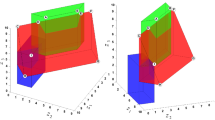Abstract
Multi-objective optimization problems (MOPs) commonly arise in various applications of engineering and management fields. Many real-world MOPs are mixed-integer multi-objective optimization problems (MMOP), where the solution space consists of real and integer decision variables. The research regarding MMOPs is still scarce due to the mixture nature of the solution space and difficulty of finding the set of trade-off solutions. In this work we propose a continuation based method that efficiently solves MMOP problems. Our method, called Enhanced Directed Search (EDS), is capable of steering the search along a predefined direction along the Pareto front in the objective function space. EDS traces the Pareto front by following closest predictor and corrector solutions in the course of optimization. By searching around the objective function boundary, EDS can solve problems with \(k > 2\) objectives. With five example problems widely studied in the literature, we demonstrate that EDS outperforms the recently developed Direct Zig Zag algorithm and the popular NSGA-II method.











Similar content being viewed by others
Notes
If the rank of \(J := J(x_0)\) is k (i.e., full rank), the pseudo inverse is given by \(J^+ = J^T(JJ^T)^{-1}\).
References
Audet, C., Savard, G., & Zghal, W. (2008). Multi-objective optimization through a series of single-objective formulations. SIAM Journal on Optimization, 19(1), 188–210.
Coello, C., & Cruz, N. (2006). Multimodal function optimization based on particle swarm optimization. IEEE Transactions on Magnetics, 42(4), 1095–1098.
Coello, C., Lamont, G., & Van Veldhuizen, D. (2007). Evolutionary algorithms for solving multi-objective problems. New York: Springer.
Das, I., & Dennis, J. (1998). Normal boundary intersection: A new method for generating the pareto surface in nonlinear multicriteria optimization problems. SIAM Journal on Optimization, 8(3), 631–657.
Deb, K., Pratap, A., Agarwal, S., & Meyarivan, T. (2002). A fast and elitist multi-objective genetic algorithm: NSGA-II. IEEE Transactions on Evolutionary Computation, 6(2), 182–197.
Ekhtiari, M., & Poursafaryi, S. (2013). Multi-objective stochastic programming for mixed integer vendor selection problem using artificial bee colony algorithm. ISRN Artificial Intelligence, 2013(1), 1–13.
Ghodsypour, S., & O’Brien, C. (2001). The total cost of logistics in supplier selection under conditions of multiple sourcing, multiple criteria and capacity constraints. International Journal of Production Economics, 73(1), 15–27.
Hillermeier, C. (2001). Nonlinear multiobjective optimization: a generalized homotophy. New York: Springer.
Hooke, R., & Jeeves, T. (1961). Direct search solution of numerical and statistical problems. Journal of the Association for Computing Machinery (ACM), 8(2), 212–229.
Karpak, B., Kasuganti, R., & Kumzu, E. (1999). Multi-objective decision making in supplier selection: An application of visual interactive goal programming. The Journal of Applied Business Research, 15(2), 57–72.
Kuhn, H., & Tucker, A. (1951). Nonlinear programming. In Proceedings of the second Berkeley symposium on mathematical statistics and probability (pp. 481–492). Berkeley: University of California Press.
Liang, J., Qin, A., Suganthan, P., & Baskar, S. (2006). Comprehensive learning particle swarm optimizer for global optimization of multimodal functions. IEEE Transactions on Evolutionary Computation, 10(3), 281–294.
Martín, A. (2014). Pareto Tracer: A predictor corrector method for multi-objective optmization problems. Master’s thesis, Computer Science Department at CINVESTAV Zacatenco.
Matlab: NGPM: A NSGA-II Program in Matlab. http://www.mathworks.com/matlabcentral/fileexchange/31166-ngpm-a-nsga-ii-program-in-matlab-v1-4 (2015). Accessed 2015
McMullen, P., & Frazier, G. (1998). Using simulated annealing to solve a multi-objective assembly line balancing problem with parallel workstations. International Journal of Production Research, 36(10), 2717–2741.
Nocedal, J., & Wright, S. (2006). Numerical optimization. New York: Springer.
Pan, W., & Wang, F. (2014). A multi-objective model of order allocation under considering disruption risk and scenario analysis in a supply chain environment. In International conference on global economy, commerce and service science (Vol. 1, pp. 325–327). Phuket: Atlantis Press
Pareto, V. (1971). Manual of political economy. New York: A. M. Kelley.
Schütze, O., Esquivel, X., Lara, A., & Coello, C. (2012). Using the averaged hausdorff distance as a performance measure in evolutionary multiobjective optimization. IEEE Transactions on Evolutionary Computation, 16(4), 504–522.
Schütze, O., Lara, A., & Coello, C. (2013). The directed search method for multi-objective optimization problems. In EVOLVE—A bridge between probability, set oriented numerics and evolutionary computation, studies in computational intelligence (Vol. 2, pp. 153–168). New York: Springer.
Schütze, O., & Martin, A. (2014). Directed Search 2. Tech. rep., Computer Science Department at CINVESTAV Zacatenco, Mexico.
Song, L. (2011). NGPM: A NSGA-II Program in Matlab. Tech. rep., College of Astronautics at Northwestern Polytechnical University, China.
Wang, H. (2013). Zigzag search for continous multi-objective optimization. INFORMS Journal on Computing, 25(4), 654–665.
Wang, H. (2015). Direct Zigzag search for discrete multi-objective optimization. Computers and Operations Research, 61, 100–109.
Zhang, Q., & Li, H. (2007). MOEA/D: A multiobjective evolutionary algorithm based on decomposition. IEEE Transactions on Evolutionary Computation, 11(6), 712–731.
Zitzler, E., & Künzli, S. (2004). Indicator-based selection in multiobjective search. In X. Yao, E. K. Burke, J. A. Lozano, J. Smith, J. J. Merelo-Guervós, J. A. Bullinaria, J. E. Rowe, P. Tiño, A. Kabán, & H. P. Schwefel (Eds.), Parallel problem solving from nature—PPSN VIII, Lecture Notes in Computer Science (Vol. 3242, pp. 832–842). Berlin: Springer.
Acknowledgements
The authors acknowledge funding through Conacyt project. no. 285599.
Author information
Authors and Affiliations
Corresponding author
Rights and permissions
About this article
Cite this article
Wang, H., Laredo, D., Cuate, O. et al. Enhanced directed search: a continuation method for mixed-integer multi-objective optimization problems. Ann Oper Res 279, 343–365 (2019). https://doi.org/10.1007/s10479-018-3060-3
Published:
Issue Date:
DOI: https://doi.org/10.1007/s10479-018-3060-3




